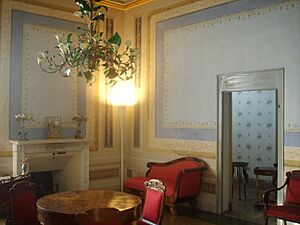Fainting room facts for kids
A fainting room was a special private room, often found during the Victorian era (from 1837 to 1901). These rooms usually had a unique piece of furniture called a fainting couch.
Fainting couches were designed for comfort. They typically had an armrest on only one side, making it easy for someone to lie down and rest. They were similar to a Chaise longue, but often had a back at one end, so you weren't lying completely flat.
Some records also mention fainting rooms in America during the 1700s. These rooms were sometimes called "bedrooms" or "chambers." They were usually on the ground floor and had a day bed, allowing people to rest for short times during the day.
Contents
Why Did People Use Fainting Rooms?
There are a few ideas about why fainting rooms became popular.
Tight Corsets and Fainting
One common idea is that women would sometimes faint because of their corsets. Corsets were tight garments worn around the waist. They were often laced very tightly. This could squeeze the ribs and make it hard to breathe deeply. If a woman was active and needed more oxygen, but couldn't fully fill her lungs, she might feel dizzy or even faint. Breathing too fast, known as Hyperventilation, could also cause a brief loss of consciousness.
A Place for Privacy and Rest
Another idea is that fainting rooms offered a private space for women. These rooms were seen as a quiet place where women could go to rest or relax. They provided privacy and comfort, especially for women who might feel unwell or simply needed a moment away from busy social life. Having such a room also showed a family's social standing.
See also
- Corset controversy
- Social aspects of clothing


